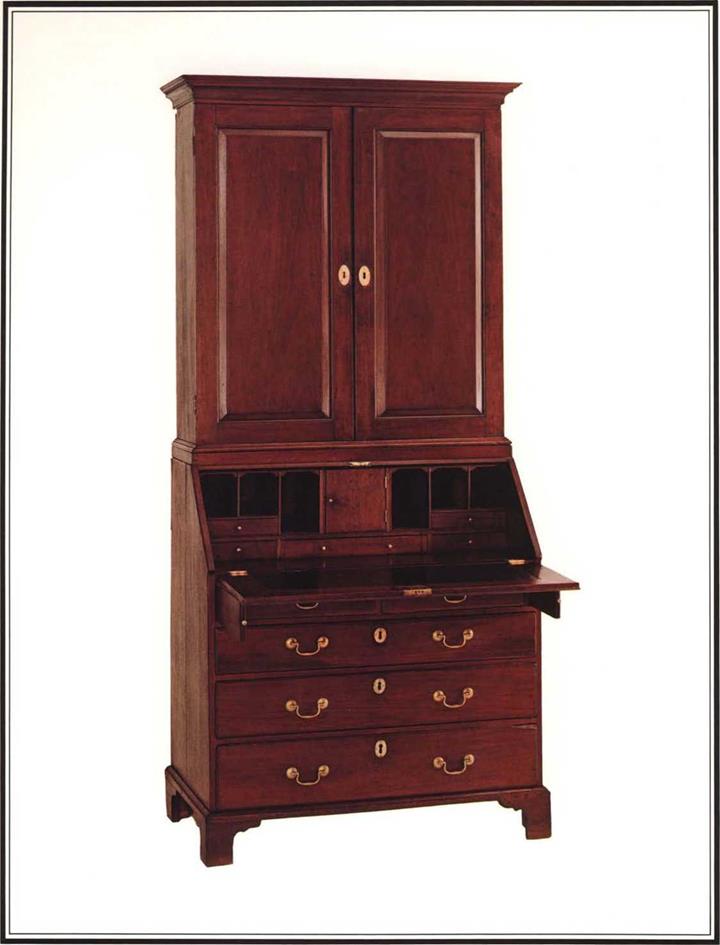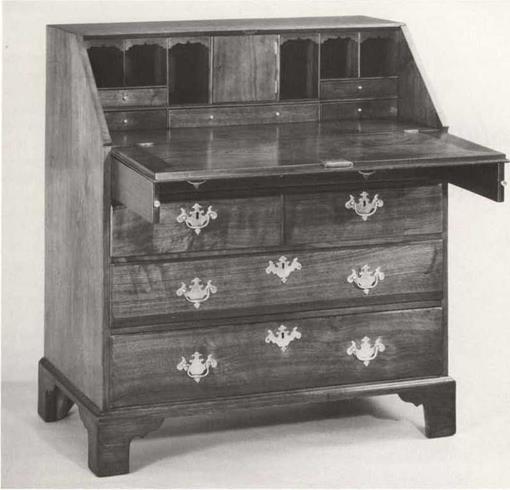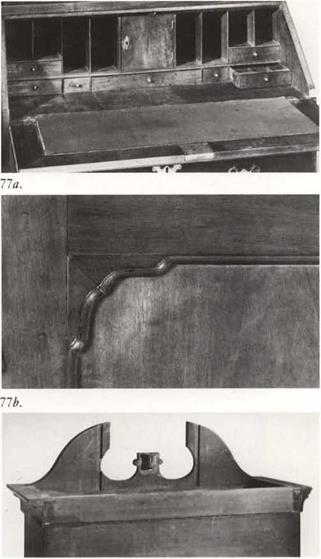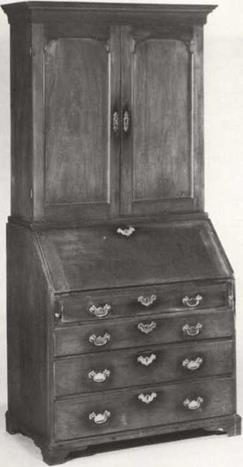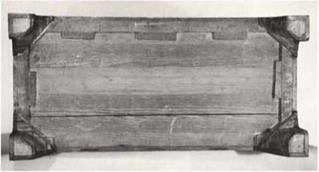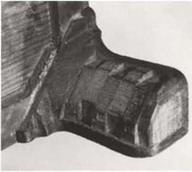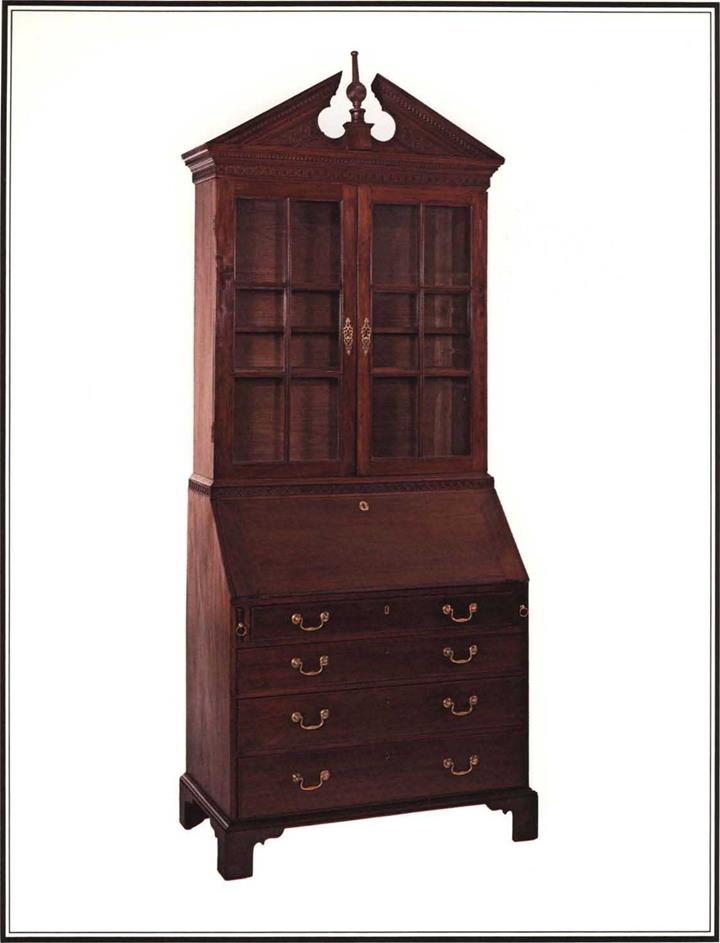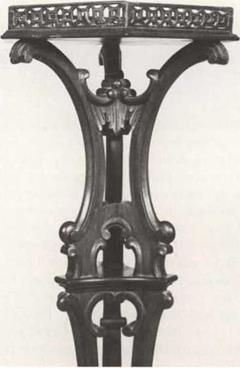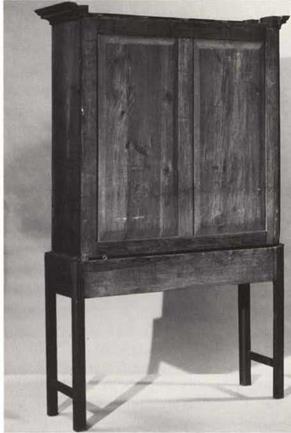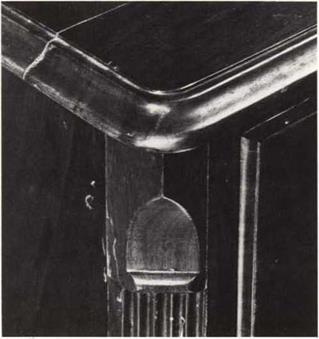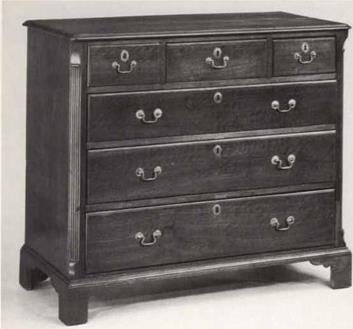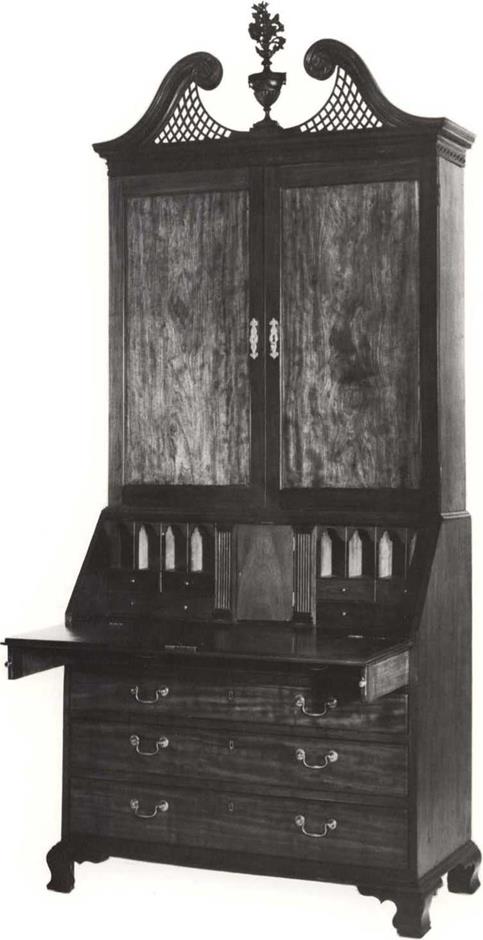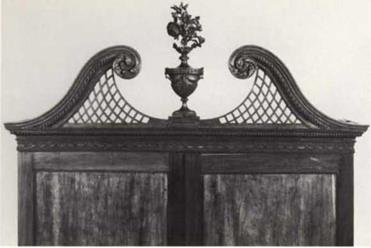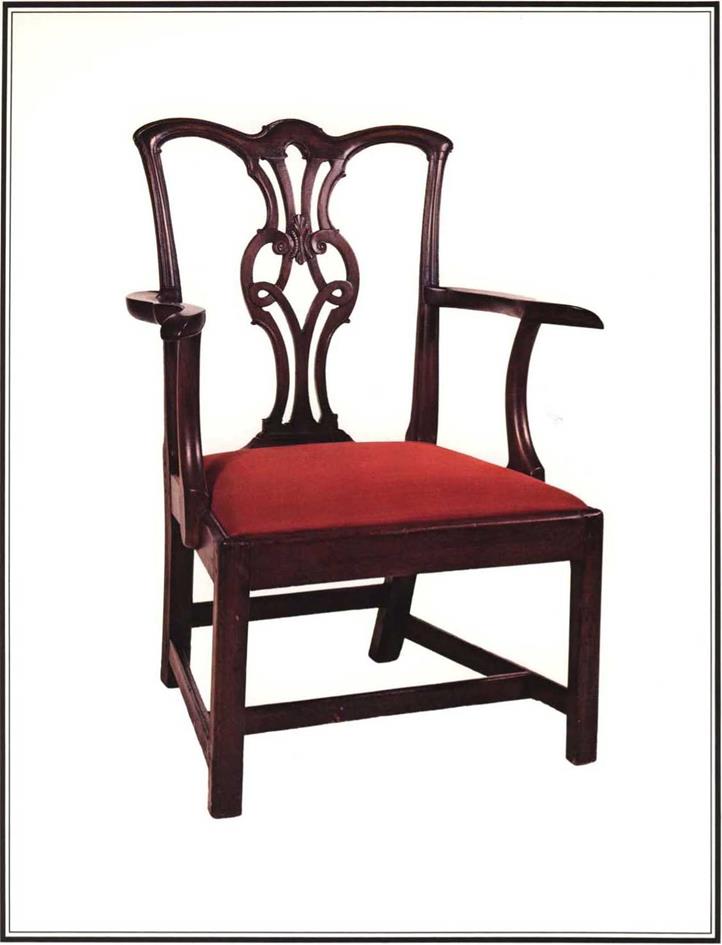The five ceremonial chairs shown in this study comprise one of the most important groups made in eighteenth-century America. Two of them (figs. 7, 46) have histories of usage in the Capitol building in Williamsburg. The remaining three are Masonic Master’s chairs (figs. 47, 49, 59).
As a rule, furniture from eastern Virginia is stylistically conservative, relatively plain on the exterior, and extremely well constructed. These five chairs represent opposites of this general stylistic trend. They are the most exuberant, fully decorative examples from the colonial Tidewater area. This contrast reflects the society that produced and used them: a society that emphasized elaborate public ceremony, as opposed to a conservative approach to private life.
The Capitol Speaker’s chair is known to have influenced the design of a similar chair in the Court House of Chowan County in Edenton, North Carolina.76 In fact, its extended back and architectural pediment are not even unique in Williamsburg, for a chair with these features was built into the James City County Courthouse when it was constructed in 1770. Although that chair no longer survives, its shadow outline still exists on an interior brick wall of the building. Another impressive example to survive from this early period is the lion’s-head armchair made for the Capitol (fig. 46), which may have served as the governor’s seat in the General Court or the Council Chamber. Extraordinary proportions, with tall legs and a high scat requiring the use of a footstool, distinguish this piece from others in the group. Ceremonial seating furniture of a commanding height was used in England, the most notable example being the royal throne. Some English Masonic Master’s chairs were made with seats of comparable height, but this Williamsburg example is unique in American furniture. With well executed carving and a fully upholstered frame, it ranks as one of the most sophisticated ceremonial chairs produced here or abroad.
Three Masonic Master’s chairs attributed to the Hay shop have a wealth of Masonic symbolism that gives insight into the political, stylistic, and phil osophical awareness of eastern Virginians. These chairs were used in lodges of accepted (or speculative) Freemasons that developed from older organizations of practicing (or operative) stonemasons. By 1717, when the first Grand Lodge of Free and Accepted Masons w as established in London, freemasonry lost all connection w ith these early groups and had developed into a society of various
trades and professions hound together for social and benevolent purposes. It w as during these early years that a system of ethical and philosophical teachings evolved, utilizing the tools and emblems of the operative masons as symbols.
The Master’s chair of W illiamsburg’s Lodge Six (tig. 47) is the earliest of these pieces and has been in continuous use since it w as made. The top of its back bears the arms of the first Grand Lodge, which were appropriated in 1717. These are flanked bv the rose and thistle, representing the union of England and Scotland that formed Great Britain in 1707.77 This upper section is supported by three stop-fluted pilasters, which, in English examples, would have capitals placed in ascending position of importance, from left to right: dorie, ionic, and Corinthian. I lere, instead, they are Corinthian, ionic, and composite. The substitution of the elaborate composite order for the simple dorie and the apparent lack of traditional order is also found in another combination in the Bucktrout chair (tig. 49a), with its central composite capital flanked by two Corinthian ones. This might suggest that the orders on these chairs were rearranged for aesthetic purposes. But the columns of the Fredericksburg Lodge Four chair (tig. 59) have capitals placed in ascending order, although again the dorie has been omitted in favor of the composite. This absence of the dorie on all three chairs, and the rearrangement of the sequence on two examples, may well represent a development in Virginia Masonic symbolism that has long since passed into obscurity. It certainly seems to have no other parallel in English or American examples.
Betw een the pilasters of the Lodge Six chair are carved a number of symbols important to an eighteenth-century mason. Several of these appear to be copied directly from a print published in London in 1754. Entitled A Free Mason Formed oat of the Materials of bit Lodge, it features an abstracted human composed not of flesh and bones but of Masonic emblems.78
Elements on this chair back related to the print include a Bible on the left and a “tracing board’’ on the right, the latter with a chip border composed of triangular segments. This board bears the geometric figure of the 47th proposition of Euclid, better known as proof of the Pythagorean theorem. Initially, this proof w as important to practicing masons in truing their squares; it then became an integral symbol of speculative Masonry. The decorative borders on the cover of the Bible are also similar to those shown in the 1754 print, as are several combinations of other symbols.
The Master’s chair by Benjamin Bucktrout (tig. 49) bears a number of Masonic emblems that are executed more realistically than those of the other chairs treated here. I he Bible is opened to “Kings I: Chapter VII,” w hich contains a description of the building of Solomon’s temple. According to tradition, this marked the beginning of all Mason’s organizations. The Bible originally had a five – pointed star applied to its center, and it is overlaid with a compass and a square of fine workmanship. The compass is realistically depicted anti the square is inscribed w ith the 47th proposition on its left tip. The trowel at the upper right has a gilded ferrule, and is only one of many elements that are highlighted by gilded decorations.
The chairs of the Master and Senior W arden of Fredericksburg’s Lodge Four have several rather unusual Masonic motifs (figs. 59, 60a). I he backs were apparently made from the same plan, but they differ in two ways. The first is the relationship of the compass and square that denote the various levels of achievement within Freemasonry.79 The most intriguing difference, how ever, is seen in the interpretation of the 47th proposition, w hich is rendered as three carved blocks sitting upon a scroll. On the simpler example these blocks are shown in their proper relationship. On the master’s chair, how ever, they are disassembled—a feature unknow n on any other example in either England or America. It is possible that this unusual version symbolizes the know ledge of assembly which is passed from master to master, but the true meaning may never be known.
Several other unusual symbolic details are found on these chairs. The bases of the splats are formed by ziggurats with nine terraces. These terraces may allude to Zeus’ nine daughters, mythological Greek muses who presided over art, poetry, and science. During the early 1770s, several London Masonic lodges were named after these muses, which is not unexpected considering the rise of the neo-classic movement and its pronounced influence on Freemasonry. Certainly the appearance of neo-classic moldings on this chair, which have already been discussed at length, coincides w ith the documented introduction of the neo-classic style in W illiamsburg in the 1770s.
Over the terraces on the splats are traditional emblems of mortality—the coffin with skull and crossbones. Above these are a Bible, a compass, and a square, flanked by crossed pens (the jewels of the secretary) and crossed keys (the jew els of the treasurer). On top of the lectern is a sundial, a somewhat unusual feature since the hourglass is more commonly used in English Masonic iconography to denote the passage of time. The sundial of the senior warden’s chair has the incised numeral “XII,” w hile
 footnotes
footnotes
1. ГЬс I lay Shop’s prominence in American cahinctmaking is established by its production of elaborate forms not seen elsewhere in America. These include lion’s-head arm terminals, dolphin feet, smooth-paw animal feet, and the group of exceptional ceremonial chairs. The documented use of Thomas Chippendale’s The Gentleman and Cabinet-Makers Director also distinguishes this shop from most others in colonial America.
2. The Virginia Gazette, ed. Alexander Turd ie and John Dixon, January 17, 1771, p. 3.
3. Ibid., January 3, 1771, p. 3; and March 9, 1769. p. 3.
4. The Virginia Gazette Day Book, Alderman Library, University of Virginia, Charlottesville, July 27, 1751.
5. The Virginia Gazette, ed. William Hunter, November 7, 1751, p. 2; The Virginia Gazette Day Book, November 7, 1751.
6. The Virginia Gazette, November 28, 1751, p. 4.
7. The Virginia Gazette Day Book. Entries of December 31, 1751, and May 28, 1752.
8. York County Deeds, No. 6, 1755-1763, p. 65. Cited by Mills Brown, "Cabinctmaking in the Eighteenth Century” (unpublished research report, Williamsburg: Colonial Williamsburg Foundation, 1959) p. 123, footnote 18.
9. Personal communication from Ivor Noel I lunte.
10. The Virginia Gazette, ed. William Hunter, June 20, 1755, p. 3.
11. Ibid., March 21, 1755, p. 4.
12. Ibid., June 20, 1755, p. 3.
13. Brown, "Cabinctmaking,” p. 127.
14. The Virginia Gazette, January 8, 1767, p. 3.
15. Brown, “Cabinctmaking," p. 127.
16. The Virginia Gazette, ed. Purdieand Dixon, January 17,1771, p. 3.
17. Ibid., December 13, 1770, p. 2.
18. Ibid., January 8, 1767, p. 3.
19. Bucktrout was probably a journeyman when he worked for Hay. This assumption is based on the fact that he bought a large number of tools and unfinished chairs from the estate of John Ormcston, a Williamsburg cabinetmaker w ho died in 1766, and shortly thereafter advertised his new business near the Capitol, quite possibly at Ormcs – ton’s old location. Since Bucktrout apparently took advantage of opportunities presented him upon Ormeston’s death, it is likely that he was a journeyman able to leave Hay’s employment when he pleased. Had he been a servant, on the other hand, he would not have had the freedom to move until his indenture was completed. Ormcston sale information courtesy of Harold B. Gill, Jr., historian. Colonial Williamsburg Foundation, Williamsburg. Virginia.
20. The Virginia Gazette, ed. Purdie and Dixon, July 25, 1765, p. 3.
21. Brow n, “Cabinctmaking," p. 143.
22. Ibid., p. 141.
23. Ibid., p. 146.
24. The Virginia Gazette, ed. Purdie and Dixon, March 9, 1769, p. 3.
25. Ibid.
26. Ibid., September 7. 1769, p. 4.
27. Robert Carter Papers, Virginia I listorical Society, Richmond, Virginia. M-82-8. Reference courtesy of Harold B. Gill, Jr.
28. Ibid.
29. Ibid.
30. The Virginia Gazette, ed. Purdie and Dixon, April 4, 1771, p. 3.
31. The Virginia Gazette, ed. John Dixon. February 4. 1775, p. 3.
32. Carter Papers.
33. Ibid.
34. Brown, "Cabinctmaking." p. 142.
35. Ibid., p. 141.
36. The Virginia Gazette, ed. John Dixon, August 28, 1779. p. 3; Brow n, "Cabinctmaking." p. 144.
37. “Cabinctmaking," p. 145.
38. Ibid., pp. 146 and 148.
39. Ibid., p.131.
40. The Virginia Gazette, ed. Purdie and Dixon, January 3, 1771. p. 3.
41. Ibid., November 14. 1771, p. 2; Brown, "Cabinetmaking,” p. 108-109; date of Tyree apprenticeship courtesy of I larold B. Gill. Jr.
42. The Virginia Gazette, ed. Purdie and Dixon, July 28, 1774, p. 3.
43. Information courtesy of Harold B. Gill, Jr.
44. Brown, “Cabinctmaking," p. 134.
45. Ibid., pp. 133-134; Thomas Jefferson Bill courtesy of Charles Granquist.
46. Brown, "Cabinetmaking," p. 133.
47. Ibid., p. 135; Ijondon Gentlemen’s Magazine 48 (September 1778): 420. Reference courtesy of Harold B. Gill, Jr.
48. Ivor Noel Hume, Williamsburg Cabinetmakers: The Archaeological
Evidence (Williamsburg: Colonial Williamsburg Foundation, 1971), pp. 39-40.
49. The history of this table was related to the author by Miss Dorothy Fitzgerald in the summer of 1977. Additional information on the Irby family came from Virginia Fitzgerald Jordon, The Captain Remembers: The Papers of Captain Richard Irby (Blackstonc, Virginia: Nottoway County Historical Association, 1975).
50. These constructions clearly relate to Chinese examples that have miters at their skirt and leg joints. See Gustav Eckc, Chinese Domestic Furniture (Rutland, Vermont, and Tokyo, Japan: Charles K. Tuttle, 1962).
51. The history of this table is thoroughly discussed in an article by J. McKenzie Semple, “Loo Table Much Traveled Piece," Antique Monthly 8 (October 1975) section A, p. 13.
52. The earliest documentation tin the use of this chair in the Capitol at Williamsburg is recorded in the June 16, 1866 issue of Frank Leslie’s Illustrated Newspaper, a copy of which is deposited in the Department of Collections, Colonial Williamsburg Foundation, Williamsburg, Virginia. Engravings of it and the Speaker’s Chair (fig. 7) are accompanied by a short article that states that they were moved to Richmond from Williamsburg, and had been in constant use since the move. At that time this chair (fig. 46) served the Senate, while the Speaker’s Chair (fig. 7) served the House of Representatives [Delegates]. The twentieth-century history of this chair is recorded in file folder no. 1930-215, the Department of Collections, Colonial Williamsburg Foundation.
5 3. Engravings of the I louse of Lords and the I louse of Commons arc illustrated in H. M. Colvin, History of the King’s Works, (London: Her Majesty’s Stationery Office, 1976), Vol. 5 (1660-1782), plates 51 and 53. The chairs shown in these prints are nearly identical in form to those of the Virginia Capitol.
54. R. VV. Sy monds, English Furniture from Charles II to George П (New York: International Studies, Inc., 1929), figs. 16 and 17, p. 38; figs. 19 and 20, p. 41.
55. Despite all these differences in quality and design, one very puzzling features ties the carving of these two chairs closely together. On each chair the lion’s head on the right arm has a more pointed face and is looking up at a higher angle than the lion on the left. The latter has a (latter, broader face and appears less sculptural, with a more box-like shape. Their size difference indicates that they were not cut from the same patterns (patterns that could have transmitted this difference from right to left). Therefore, the fact that both chairs have great difference in proportion from right lion to left lion, appears to be a very personal trait of the carver. This unusual characteristic strongly indicates that both chairs were carved by the same hand. Perhaps a decade or more separates their production, which accounts for the diminished quality.
56. ‘This chair was illustrated and discussed in Thomas G. Parramore, launching the Craft: The First Half-Century of Freemasonary in North Carolina (Raleigh: I. itho Industries, 1975), pp. 71-72. It was extensively examined and illustrated by Bradford L. Rauschenberg in " Two Outstanding Virginia Chairs, "Journal of Early Southern Decorative Arts 2 (November 1976): 11-20.
57. Rauschenberg, "Chairs," pp. 19-20.
58. Ibid., pp. 15-16.
59. A similar arm piercing is shown in plate 17 of the first edition of the Director. This is the first of four plates that illustrate French chairs, and from the last plate in this series Bucktrout used the dolphin leg design. Since plate 17 is not in later editions of the Director, and since other Hay Shop ornament derived from the Director does not occur in later plates, it appears that the copy in use in the Hay Shop was a first edition, published in 1754. All further references to the Director in this study w ill be cited from the third edition, 1762, reprinted Ьуґ Dover Publications (New York, 1966).
60. "Dressing chest and bookcase" is the term used to describe this form in Chippendale’s Director (cf. plates 114, 115).
61. Ibid., p. 7.
62. Symonds, English Furniture, pp. 100-101, diagrams 4a, 4b.
63. Will of Mrs. Mary Wilting Byrd of Westover, 1813, witha list of Wcstovcr portraits, Virginia Magazine of History and Biography 6 (1899): 356, note 28.
64. Illustrated Catalogue of the Rare and Extremely Choice Collection of F. arly American and English Furniture formed by Louis C. Myers (New York: American Art Association, 1921), entry no. 668.
65. E. Milby Burton, Charleston Furniture, I700-I82S (Charleston, South Carolina: Charleston Museum, 1955), p. 43.
66. Catalogue, “Art Loan Exhibition for the Benefit of the Ladies Parish Aid Society of St. Paul’s Church, Norfolk, Va., at Mechanics Hall, May 27, 1879,” (Norfolk: no publisher) entry no. 302. Research Library, Colonial Williamsburg Foundation, Williamsburg, Virginia.
67. Rauschenberg, "Chairs," pp. 1-11. In this article Mr. Rauschenberg attributes this chair to an unidentified cabinetmaker in Fredericksburg.
68. Ibid., pp. 6-8. Mr. Rauschenberg states that the gadrooning of this chair is nailed to the bottom of the scat rail, and that the front knee-blocks are also attached underneath. These statements are not correct; the gadrooning and knee-brackets are glued to the face of the scat rail (see figs. 59c, 59f). This construction conforms to that of the Scott group, and is the same group treated by Harold B. Gill, Jr. and the author in "Some Virginia Chairs: A Preliminary Study,” The Magazine Antiques 101 (April 1972):716-721.
69. Chippendale’s Director, plate 10.
70. Desmond Fitz-Gerald, cd., Georgian Furniture (London: Her Majesty’s Stationery Office, 1969), entry no. 103.
71. Helen Comstock, “Discoveries in Southern Antiques," The Magazine Antiques 65 (February 1954): 131-133.
72. Helen Comstock, American Furniture (New York: Viking Press, 1962), no. 278.
73. Helen Comstock, “F’urniture of Virginia, North Carolina, Georgia, and Kentucky," The Magazine Antiques 61 (January 1952): 68, plate 62.
74. Noel Hume, Williamsburg Cabinetmakers, p. 27, fig. 20.
75. Ibid., fig. 19.
76. Johnston and Waterman, Early Architecture, p. 249, plates p. 268.
77. Identification of the arms on this chair, and a research report on the Masonic aspects of these chairs, were forwarded to the author byf T. O. Haunch, librarian and curator. United Grand Lodge of England, on March 26, 1977. The report is now in the research files of the Archives and Records, and in the Department of Collections, at Colonial Williamsburg. Without the considerate help of Mr. I launch, it would have been impossible to write this section on Masonic symbolism.
78. A photostatic copy of this print was supplied by Mr. I launch in the report cited in footnote 77.
79. Because of the relationship betw een the squares and compasses, Fredericksburg Lodge IV today uses the elaborate Master’s ( diair as the Senior Warden’s, and the simpler Warden’s Chair as the Master’s. Apparently this is the result of a stricter interpretation of these symbols than that practiced in the eighteenth century. The most elaborate and grandest chair in the set was alw ays the Master’s. ‘The purpose of the degree of decoration was to designate rank and order. This held true for government as well as for royal chairs. It is not known when the reversed usage of these Lodge IV chairs first occurred; apparently it is a fairly old tradition predating the present generation.
|
|
Several groups of case furniture survive that can be identified as Williamsburg production, although attribution to specific shops is tenuous at this time. The first and largest of these may represent the Anthony I lay Shop, although evidence is not yet conclusive.

 This “Hay” group consists primarily of desks, desk-and-bookcases, and clothespresses. They are made of mahogany or walnut, with yellow pine secondary wood, and have an amazing degree of consistency in construction. The cases invariably have dustboards that are equal in thickness to the drawer blades and that extend the full depth of the case—a type that has been termed “full bottom” by one of the leading British furniture historians, R. W. Symonds. These cases are supported by composite feet and the base molding is a simple quarter round similar to those illustrated in Chippendale’s Director.
This “Hay” group consists primarily of desks, desk-and-bookcases, and clothespresses. They are made of mahogany or walnut, with yellow pine secondary wood, and have an amazing degree of consistency in construction. The cases invariably have dustboards that are equal in thickness to the drawer blades and that extend the full depth of the case—a type that has been termed “full bottom” by one of the leading British furniture historians, R. W. Symonds. These cases are supported by composite feet and the base molding is a simple quarter round similar to those illustrated in Chippendale’s Director.
Two desks in this group (figs. 75, 76) have interior w riting cabinets with a design seen on many Williamsburg examples. The design is characterized by a long central drawer with a nearly square prospect door above. The interiors have straight drawer fronts and they are strikingly similar to a large group from Piedmont Virginia and suggest a connection between the two areas.1 Like the Williamsburg examples, the Piedmont interiors feature the long central drawer and square prospect door, but they are significantly different in having their lower drawers advanced, giving a stepped effect. In most examples, several drawer fronts are “blocked” in serpentine or double ogee shapes. Stylistically, these stepped and blocked Piedmont interiors are earlier than their related Williamsburg examples, but it is possible that they represent an early stage of design in the colonial capital, transplanted into the Piedmont by artisans trained in that city. If this is the case, then the form must have had a fairly brief popularity in Williamsburg, although in the Piedmont it persisted into the nineteenth century.
The first of these Williamsburg desks has a Richmond area history of ow ncrship and is dated 1758 on the bottom of a drawer (fig. 75). It is constructed of w alnut with yellow pine. Its drawer blades are thin and, like all examples in this group, it has full-bottom dustboards. The draw ers of the main case have runners like those of the Scott group (fig. 37g) but do not have the large glue blocks across the front. It is also similar to the Scott desk (fig. 37) in the layout of the main case draw ers. The feet have been replaced, although the originals had composite blocking.
One example from this group (fig. 76) has a desk section nearly identical to that of the 1758 example. Made of black walnut and yellow pine, it has a
|
tradition of ownership in Williamsburg by John Minson Galt, w hose apothecary shop was located on the Duke of Gloucester Street. Slight variations in the partitions between the lower drawers of the writing interior and the design of the pigeonhole brackets are the only departures from the preceding desk. The case is identically constructed. It also has original bracket feet, although only one of these retains its composite blocking. The bookcase section does not sit directly on the top as in most American examples but, like other Williamsburg pieces, fits within a frame attached to the desk section. The shaped molding at the top of the frame is attached to the bookcase section, forming a strong “interlock joint.” (This term w ill be used throughout the rest of this book to describe this construction, which is a major characteristic of the group.) Several variations w ere employed, and these too w ill be illustrated and discussed as this study proceeds. Its origin is
suggested by plate CIX of Chippendale’s Director, which shows a bookcase having a fret-decorated frame in the same location. A similar desk-and – bookcase (not illustrated), w hich remains in the Galt family, has an interlock joint into which two slides for candles arc fitted. The cornice of each piece is detachable.
Another desk-and-bookcase from the Galt Family has suffered some damage over the years (fig. 77). In this piece, only the upper portion of the composite blocking survives, and the short bracket feet are complete replacements. The interlock joint has lost the top molding, w hich was glued into a shallow rabbet on the bookcase, and the broken scroll pediment has been severely altered (fig. 77c). The re-cutting of the pediment has virtually destroyed all traces of the original form; it is an unfortunate loss. (The condition of the pediment is so disruptive that it was not included in the photograph.) It appears that
|
|
|
|
|
the original had a bonnet top, judging from the vertical slots that remain in the back. The brasses on this desk-and-bookcase are original, which would seem to indicate an earlier date that suggested by the flat panels of the bookcase section. The construction of the lower case, the drawers, and the detachable cornice are virtually identical to the preceding examples. I low ever, one significant difference is found in the construction of the doors, which have panels set into a rabbet instead of a groove and held in place with small forged nails. This rabbetted construction is related to the Scott group, as are the ogee spandrels. Such an incorporation of details from other Williamsburg masters is quite similar to that seen in Hay shop products, and the use of black walnut as a secondary wood is an important practice also observed in the Bucktrout and Lodge Four chairs (figs. 49, 59). Other examples that show a combination of Scott features with details and
techniques of the early I lay shop include a side table (fig. 53) and three chairs (figs. 58, 59, 60). Case pieces yet to be discussed reveal additional interrelationships between these two groups.
A mahogany desk-and-bookcase closely related to the preceding example is pictured in the files of the Museum of Early Southern Decorative Arts (S – 3888). It has flat panels, is currently lacking its spandrels, and has an interlock joint identical in construction to those just discussed (figs. 76, 77). The writing interior is nearly identical to figure 76, as are the base moldings and bracket feet. The primary wood is mahogany, seen in other Williamsburg examples, and contains the sporadic groups of burls also found in the unfinished table leg from the I lay shop (fig. 66).
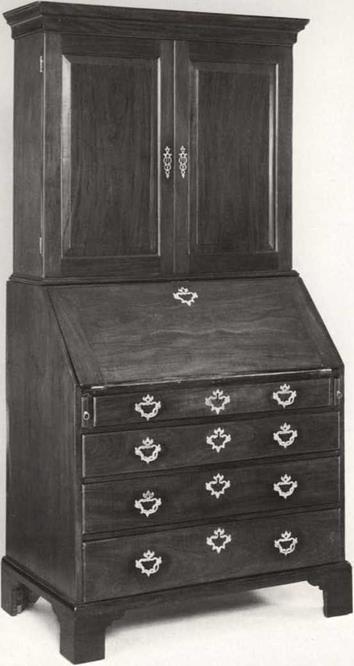
78. Desk-and-Bookcase, Williamsburg, 1771-1175. Mahogany primary; yellow pine secondary.
Height 74V*", width 39V*", depth 23V*".
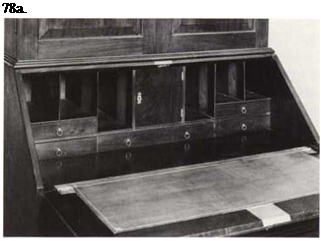 The Colonial Williamsburg Foundation (ace. no. 1951-489).
The Colonial Williamsburg Foundation (ace. no. 1951-489).
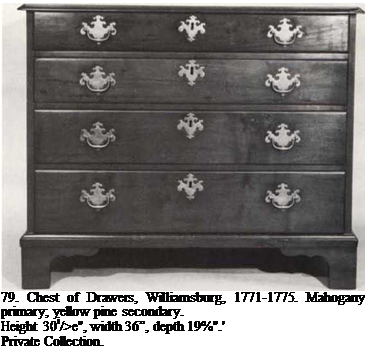
Two pieces in this group, a desk-and-bookcase anti a chest of draw ers (figs. 78, 79), are made of fine curly mahogany. An oral tradition relates that the desk was purchased by William Trebell from the Governor’s Palace, and w ritten documentation dating to the 1880s indicates that the chest of draw ers was purchased at the sale of Lord Dunmore’s possessions in 1776.2 Unfortunately, there is no record of Trebell among the debtors at the sale, but this does not negate the tradition since he may have acquired one or both of these pieces front another purchaser, or possibly had someone else bid for him. To confuse the issue, Trebell is known to have purchased items from the sale of Lord Botetourt’s estate in 1770, and it is possible that by the 1880s this fact had become obscured. Nonetheless, they appear to have come from the same shop, since they exhibit the same construction, and w ere probably made en suite.
Although this Palace desk-and-bookcase essentially repeats a familiar pattern, it has one major departure from the others: the usual interlock joint has been replaced by a low molding attached to the bookcase sides. It is unusual to attach the molding in this location, but the greatest variation here is in the omission of the supporting frame betw een the upper and lower case. To achieve stability, four pegs project from the bottom of the bookcase and engage corresponding holes in the top of the desk. Such construction might suggest that the two portions were made at different times, but close comparison of the fine curly mahogany, the secondary woods, and the workmanship indicates contemporaneous production. This piece shares an integral relationship with other examples in the group, and a variation of its peg construction, used in conjunction with a full frame attachment, is found on a desk – and-bookcase with a history in Amelia County (fig. 116).
The cases of this desk-and-bookcase and its accompanying chest are very well constructed. Both have full-bottom dustboards. The desk has simple bracket feet, which have now been restored; only one original bracket and its composite blocking survive. The brackets on the chest are totally replaced, but evidence of their composite blocking remains. The base molding is original, as are the brass pulls and plates, although the escutcheons appear to be replacements. The pierced examples of the desk are replaced, based on outlines left by the originals.
The drawer construction of these two examples closely coincides. The quarter-round “lip” molding is cut from the solid edge of the drawer face and does not overlap the case. The drawer bottoms are nailed into a rabbet and are covered by strips of pine on the
front and sides. On the desk-and-bookcase these strips are mitered at the front corners, but on the chest the side strips abut the drawer front, conforming to those found on earlier desks in this group.
The high quality material and excellent workmanship of these two pieces are representative of case furniture made in Williamsburg. Their severe lines characterize the period of transition from the rococo to the neo-classic, and are good representatives of the plain style that dominated cabinet design during the 1760s and 1770s.
Even though all the preceding examples have suffered some losses to their feet and composite blocking, two clothespresses owned in the Galt family of Williamsburg have survived in virtually unaltered condition. One of these is made of walnut and yellow pine and has a paneled back (fig. 80a).
Attached to the bottom are long strips of yellow pine which support the base molding (Hg. 80b). A close look reveals that these strips have saw kerfs cut through them (fig. 80c). The bottom of the base molding is also kerfcd (visible at the top right and left in the illustration), hut they do not continue through the front of the molding. These kerfs serve the purpose of allowing expansion and contraction of the wood as it responds to humidity changes, thus alleviating the strain on the glue joints and on the case. Examples without these constructional allowances are often damaged by humidity changes that cause their sides or bases to split, or that break their glued joints. The paneled back serves the same purpose and also prevents gaps from developing between the boards when extreme shrinkage occurs. The composite blocking of the feet (fig. 8()d) also has this advantage, and the fact that the grain runs in the same plane as that of the brackets gives them a compatible ratio of expansion and contraction. This foot construction provides more strength than the single vertical block more commonly used in cabinetwork from other areas. These refined construction techniques, virtually unknown in New England and Philadelphia, arc also seen in Norfolk examples and are found on urban English products.
The second clothespress (fig. 81), somewhat more elaborate, has an additional raised panel in each door and two drawers w ithin. The base and feet are almost identical in construction to the preceding example, but it does not have a paneled back, a feature that is seen often but is not uniform in this group.
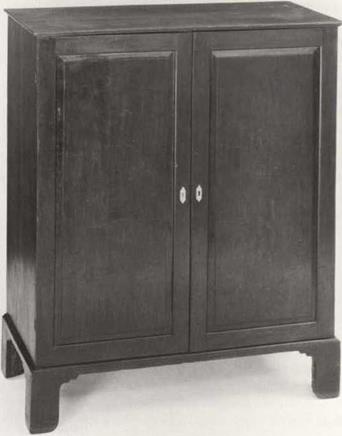
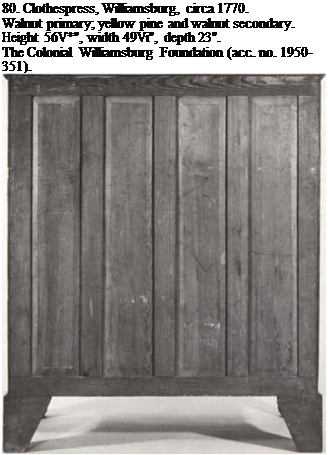 80a.
80a.
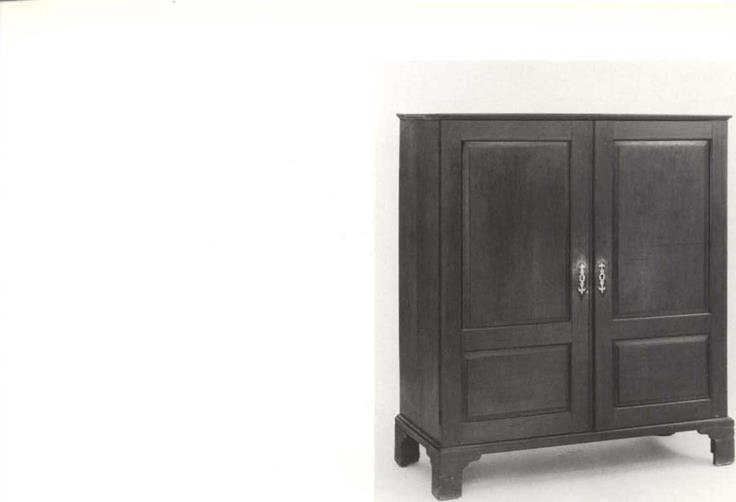
81. Clothespress, Williamsburg, circa 1770.
Walnut primary; yellow pine secondary.
Height 55’4", width 49Ун", depth 22Vh".
The Colonial Williamsburg Foundation (acc. no. 1950-350).
|
|
||
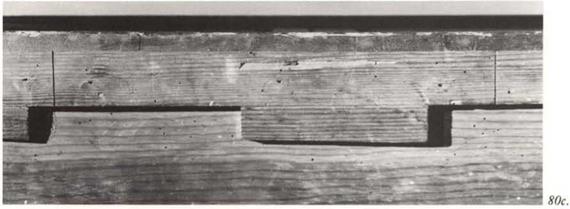
|
|
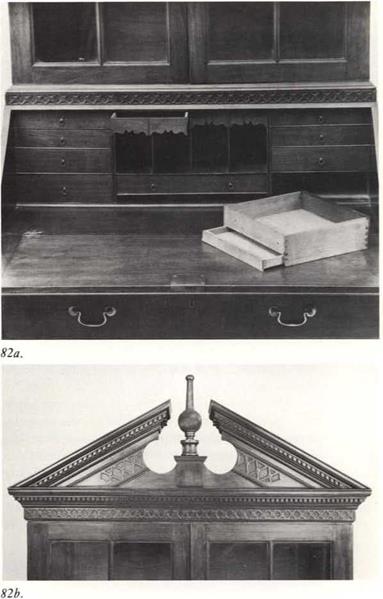
 |
An outstanding desk-and-bookcase that descended in the Galt family of Williamsburg is more impressively detailed than others of this group, but its affinity to them is nonetheless evident (fig. 82). The interlock joint, molded drawer edges, thin drawer blades, and full-bottom dustboards are all features seen on previous examples. The large drawers have bottoms nailed into a rabbet on the sides and front. A series of small blocks forms unbroken runners on the sides and a continuous series across the front. This type of blocking is different from the continuous strips seen on pieces already discussed, although they are somewhat related to draw ers in the Scott group.
Another departure from the usual construction of this group is the addition of a horizontal batten inside the back of the case. Dovetailed into the sides, it runs parallel to, and behind, the second drawer. This batten provides strong support for the sides at the back, an area of weakness in most case furniture where nailed backboards alone furnish stability.
The interior of this desk (fig. 82a) is significantly different from others examined here, although another unidentified Williamsburg shop produced similar examples.3 The sources of the design appear to be a combination of the desk interior show n in plate CVI1 of Chippendale’s Director and that shown in plate 55 of HousHold Furniture (fig. 82e).4 The fretwork designs, as well as the frame that joins the two sections, appear to combine elements from both of these works. The use of the frame interlock joint may be derived from plate CIX of the Director, while the design of its fret is a slight variation of one shown in plate 72 of HousHold Furniture (fig. 82f).
The broken-pitch pediment of this desk-and – bookcase is the finest to survive from Williamsburg (fig. 82b). Its most noteworthy feature is the molding, which is designed in perspective, indicating a maker with exceptional skill and an understanding of design (fig. 82c). The fretwork pattern that w as used on the frame interlock joint has been reincorporated in the frieze of the pediment, but it is somew hat unusual to see a larger version of this same pattern repeated in the tympanum. The dentil work found here is exceptionally fine, and that of the central plinth is scaled in proportion to the smaller molding.
Some minor alterations have been made to this pediment, including the restoration of the w alnut, triple-fluted cylinder that supports the finial. The original had been cut in half and reapplied to the pediment of a mahogany desk-and-bookcase that descended in the same household (fig. 77c). It should also be noted that the spiral decorated finial has lost a pointed tip that extended above its flattened ball, as w ell as its flaring base moldings. A fretwork design w as originally applied to the low er portion of the plinth.
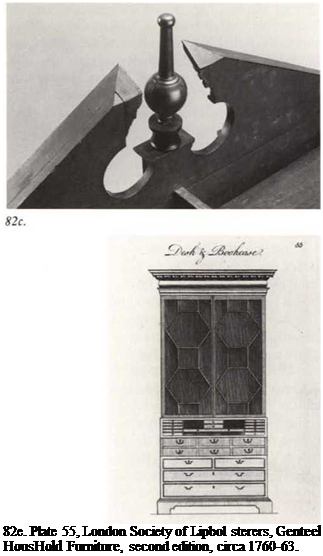 The bookcase section of this example has a finely paneled back (fig. 82d). The interior contains three shelves with seven slots for adjustment. The inside of the doors shows evidence of tack holes that originally held fabric or curtain rods. Many eighteenth-century prints show curtains on the insides of bookcases w ith glazed doors.
The bookcase section of this example has a finely paneled back (fig. 82d). The interior contains three shelves with seven slots for adjustment. The inside of the doors shows evidence of tack holes that originally held fabric or curtain rods. Many eighteenth-century prints show curtains on the insides of bookcases w ith glazed doors.
|
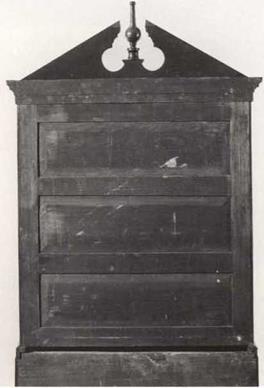
![]()
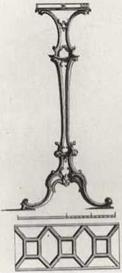
![]() 82f Plate 72, Genteel I lousl lold Furniture.
82f Plate 72, Genteel I lousl lold Furniture.
|
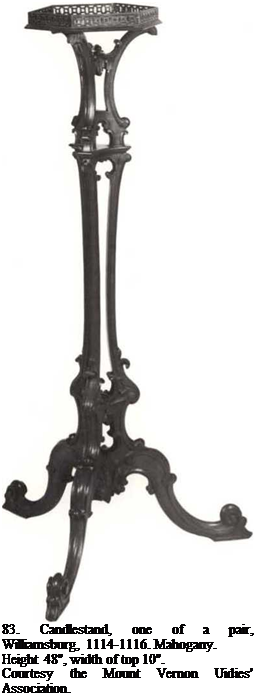 A pair of mahogany candlcstands w ith a tradition of ownership by George Washington at Mount Vernon is related to the preceding dcsk-and – bookease. Like it, the designs are taken from Hous – Hold Furniture (fig. 82f) and are virtual copies of the design book illustrations with only the slightest departures. Yet the execution of the detailed carving is substantially individualistic, and much of it indicates I lay shop production.
A pair of mahogany candlcstands w ith a tradition of ownership by George Washington at Mount Vernon is related to the preceding dcsk-and – bookease. Like it, the designs are taken from Hous – Hold Furniture (fig. 82f) and are virtual copies of the design book illustrations with only the slightest departures. Yet the execution of the detailed carving is substantially individualistic, and much of it indicates I lay shop production.
I’he most prominent feature is the large acanthus in the base with its central cabochon (fig. 83b). While this vaguely resembles the foliage of the pattern book illustration, it is more closely related to an acanthus found on the knee of the Lodge Four chair (fig. 70). This knee carving is a somewhat extruded version of that found on the stands, w ith opposing C-scrolls occupying the approximate position of the cabochon. The elements of both carvings arc extremely close, with bulbous scroll or leaf endings that have a tuckcd-under, concave leaf on the inside curves. The convex, bulbous ends of the candlestand leaves have either one or two additional gouge veins than those of the Lodge Four chair. This heavier veining, although much better executed, appears to be a survival of the earlier technique used on the foliage surrounding the coat of arms on the Lodge Six chair (fig. 47b). Likewise, the acanthus drapes from two C-scrolls just under the top (fig. 83a) and has a central stem and harshly fluted leaves that are quite similar to those found on the arm supports and knee carving of the Lodge Six chair.
|
|
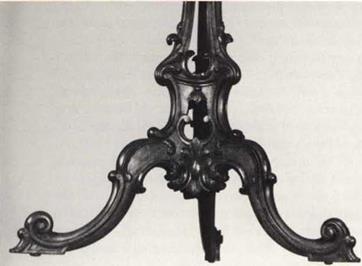
![]()
Other features exhibiting finer workmanship but hearing a relationship to the Bucktrout chair are the asymmetrical, curled-back acanthus leaves that terminate the base carving (top of fig. 83b). Of these, the last small leaf at the top, which rises and curls to the side, is strikingly similar to those on the triple acanthus rising from the C-scrolls in the middle of the Bucktrout chair dolphin leg (fig. 49g). On the stands these acanthus details represent the individual designs and techniques of the carver and they are similar to those in the design book in only a very general way. Thus, the origin of the candlestands is associated with the I lay shop, and reflects a decade of technique and design development there.
While many of George Washington’s furniture orders are extant, none is known that can be associated with these candlestands. Because of the extremely sophisticated form, the lack of secondary wood, and the triple-laminated fret gallery, they had previously been considered English. These elements
alone, however, are no longer acceptable for making such a judgment. The existence of documented examples of highly sophisticated Virginia furniture, together with the knowledge that skilled eabinet – makers and professional English carvers are known to have worked in the colonial Tidewater, have disproved many old maxims.
One extremely sophisticated example related to this group is a mahogany tall case clock (fig. 84). Its movement is by Thomas Walker of Fredericksburg, but there is every indication that the case was made in Williamsburg. It has yellow pine, poplar, oak, and cherry as secondary woods—a combination similar to pieces in the Hay group. The rosettes of the pediment are carved in perspective, and they provide an important link with the pitch pediment of the preceding Williamsburg desk-and-bookcase (fig. 84). The rosettes, which have a series of fine gouge cuts to indicate shading, are quite similar in carving technique to the fronds of the Washington candlestands (fig. 83). The dentil molding has small half-circles between the teeth, a design feature seen in the Scott group, and the quarter-columns are similar to those of the Hay shop clothespress (fig. 56). The shaped door is remarkably close to that of the dressing chest (fig. 50) also attributed to the I lay shop. These last three details are by no means conclusive evidence for relating these pieces, since they appear as somewhat standard details in furniture made elsewhere. They are mentioned, nonetheless, since they are supported by other interrelated features of a more reliable, individual nature.
For a number of reasons, the previous attribution of this clock to Philadelphia has been rejected. Importantly, the entire construction is extremely light in w eight, thus showing an affinity to F. nglish examples and contrasting with those of Philadelphia, where clock cases were usually quite heavy. A further affinity to English cabinetmaking techniques that is also representative of Williamsburg production is found in the construction of the pediment, which is composed of yellow pine with a thick veneer of mahogany. I his now has three slightly recessed panels which were originally filled with pierced fretwork installed from behind. A band of fretwork was also applied around the case, between the astragal molding above the door, although only faint evidence survives. It is important to note that this area of the case was rabbetted to receive the fretwork. This is related to the practice of rabbetting the sides of the case to receive molding for the upper half of interlock joints of desk-and-bookcases (tig. 77).
I his technique is also consistent with Williamsburg tea tables that have moldings glued into rabbets to form tray tops (fig. 57).

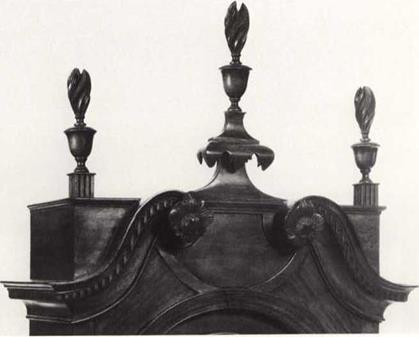 |
84. Tail-Case Clock, Williamsburg, circa 1770; movement by Thomas Walker of Fredericksburg.
Mahogany and mahogany veneer primary; yellow pine, poplar, cherry, and oak secondary.
Height 106", width (mid-case) 14 Ун", depth (mid-case) 6 Ун". Museum of Fine Arts, Boston.
НЧ. Bookcase on Stand, Williamsburg, circa 1770.
Walnut primary; yellow pine, popular, and walnut secondary. Height 67V*", width 44V*", depth 14*It*".
Dr. Janet C. Kimbrough.
|
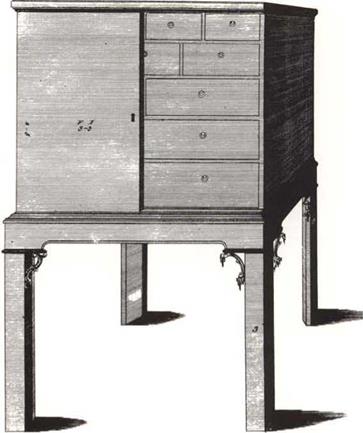
One of the most unusual pieces in this Williamsburg group is a bookcase-on-stand, which is closely related to designs shown in plate CXX of Chippendale’s Director (fig. 85). Its cornice blocking and waist moldings are related to those of Scott (figs. 37f, 42), and the paneled back and draw er construction are like those of the elaborate desk-and-bookcase in this group (fig. 82). This piece, which descended in the St. George Tucker family of Williamsburg, is further support for the attribution of these two groups to that city.
While the concept of this bookcase-on-stand seems to have been inspired by Chippendale’s Director, the maker did not follow this plan exactly, but rather utilized his standard bookcase pattern and then designed a stand to accommodate it. The use of the standard pattern alone may cause one to question the piece, but it is entirely original, w ith matching woods and a combination of shop details that are consistently repeated in both sections—indicating they were conceived together. This is not the case for two other examples that survive in Williamsburg families. Their frames were made at later dates (one ca. 1800, the other ca. 1880) to accommodate bookcases that had been separated from desks. Nonetheless, they provide additional support for the popularity of this form in Williamsburg—a type unknow n to the writer elsew here in Virginia.
85b. Plate 120, Thomas Chippendale’s Gentleman and Cabinet-Maker’s Director, third edition, 1762.
|
|
|
|
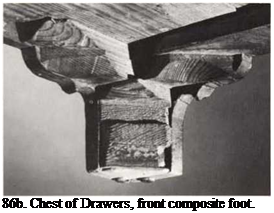
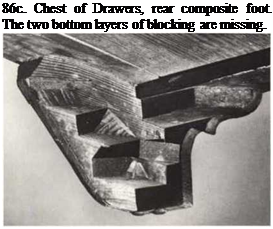 Presenting the same problem of shop identification as the bookcase-on-stand is a walnut chest of drawers that descended in the Galt family of Williamsburg (fig. 86).5 It has full-bottom dustboards, bracket feet, and chamfered corners with flutes, as well as rounded corners on the top. All of these features are seen in pieces attributed to the Hay shop, and they can also be found in other examples from this group. The composite blocking is executed like that of Scott examples and is finished in the front feet (fig. 86b) while left at random at the back (fig. 86c). The drawer bottoms are nailed into shallow rabbets and have no runners, allowing the drawers to run on the Hush surfaces of their bases. This type is also seen on an early Williamsburg dressing table (fig. 13). Incredibly, the sides of this piece are dovetailed into the solid top—a rare feature that indicates the quality of construction. The top forms both overhang and molding, which in normal construction consists of a separate applied piece. This complicated the Htting of the concealed dovetail joint that held the case together and totally eliminated the use of the dovetail saw in making the top. The dovetail mortises had to be blind cut using only chisels, although the pins were formed on the case sides with a saw and chisel in the usual manner. While many of the top lips of the drawers have been repaired, one survives intact. This provides still another variation of construction in Williamsburg, and it is the single example in which only the top of
Presenting the same problem of shop identification as the bookcase-on-stand is a walnut chest of drawers that descended in the Galt family of Williamsburg (fig. 86).5 It has full-bottom dustboards, bracket feet, and chamfered corners with flutes, as well as rounded corners on the top. All of these features are seen in pieces attributed to the Hay shop, and they can also be found in other examples from this group. The composite blocking is executed like that of Scott examples and is finished in the front feet (fig. 86b) while left at random at the back (fig. 86c). The drawer bottoms are nailed into shallow rabbets and have no runners, allowing the drawers to run on the Hush surfaces of their bases. This type is also seen on an early Williamsburg dressing table (fig. 13). Incredibly, the sides of this piece are dovetailed into the solid top—a rare feature that indicates the quality of construction. The top forms both overhang and molding, which in normal construction consists of a separate applied piece. This complicated the Htting of the concealed dovetail joint that held the case together and totally eliminated the use of the dovetail saw in making the top. The dovetail mortises had to be blind cut using only chisels, although the pins were formed on the case sides with a saw and chisel in the usual manner. While many of the top lips of the drawers have been repaired, one survives intact. This provides still another variation of construction in Williamsburg, and it is the single example in which only the top of
each drawer overlaps the case. The lip molding of the other three sides of the drawer have been cut on the solid edge like those of the desk-and-bookcase and chest from the Palace (figs. 78-79).
Two chests of drawers inspired by Chinese cabinets are also associated w ith Williamsburg shops (figs. 87, 88). Familiar features found here include the bracket foot design, quarter-round base molding, full-bottom dustboards, and drawer construction relating to three other Williamsburg desks (figs. 75, 76, 77). The feet are also related to Williamsburg composite examples, w ith a triangular block spanning the brackets of each foot, and in this respect they are virtually identical to the simplest clothes – press in the group (fig. 8()d). In the chests, however, the horizontal composite supports were replaced by large, quarter-round blocks composed of two laminated pieces with a vertical joint. This same foot construction is found on a desk in the Virginia Historical Society collection which, according to tradition, w as ow ned by Peter Jones (1691-1758) of Amelia County. The interior of the Jones desk is identical to that of figure 75. Other features, including full-bottom dustboards, bracket feet, and quarter-round base molding, place it firmly in this group. Perhaps such foot construction separates these chests and desk into yet another Williamsburg shop group.
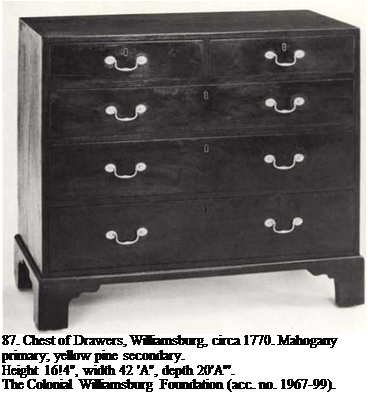
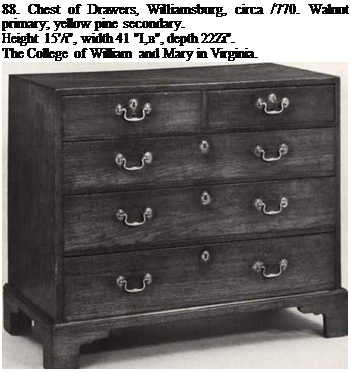 The first chest (fig. 87) is made of high quality mahogany with yellow pine secondary wood. It has a history of ownership in the Michael family of Brodnax, Mecklenburg County, Virginia. The second example (fig. 85) is constructed of w alnut with yellow pine and poplar. It belongs to the College of William and Mary. Like other examples of this form, both of these chests have large secret (not visible) dovetails attaching the tops, w hile the latter example incorporates this feature in the joining of its bracket feet. It is nearly identical to an example acquired by Colonial Williamsburg in 1938 from Charles Navis Antiques in Richmond (no. 1938-144, not pictured).
The first chest (fig. 87) is made of high quality mahogany with yellow pine secondary wood. It has a history of ownership in the Michael family of Brodnax, Mecklenburg County, Virginia. The second example (fig. 85) is constructed of w alnut with yellow pine and poplar. It belongs to the College of William and Mary. Like other examples of this form, both of these chests have large secret (not visible) dovetails attaching the tops, w hile the latter example incorporates this feature in the joining of its bracket feet. It is nearly identical to an example acquired by Colonial Williamsburg in 1938 from Charles Navis Antiques in Richmond (no. 1938-144, not pictured).
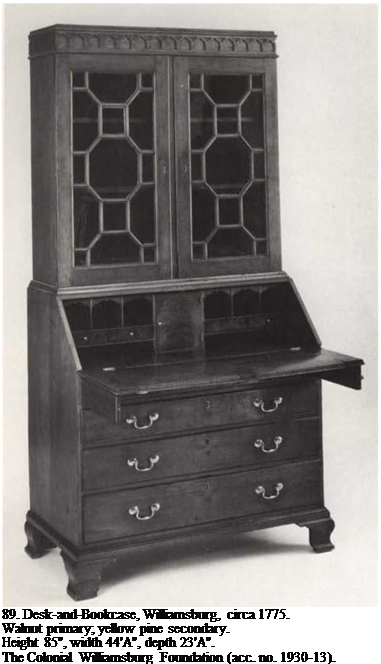 A desk-and-bookcase with a tradition of ownership by President John Tyler (1790-1862) adds considerably to our knowledge of Williamsburg cabinetmaking (fig. 89). Tyler was a native of Williamsburg, and this desk shares many details w ith pieces from the group, thus forming a strong basis for its attribution. Constructionally it combines many details seen in Williamsburg furniture and it may represent another anonymous shop. The case has full-bottom dustboards and the foot blocking was originally the composite type, although these have been replaced by vertical blocks. The same type of construction of the drawer bottoms is seen in another desk-and-bookcase (fig. 78), and the small drawer on the right of the writing interior has compartments for ink and pens that relate it to similar drawers in two other examples (figs. 77, 78). Although altered at an early date, this desk-and – bookcase originally had an interlock joint uniting its two parts. Evidence of the original joint is clearly visible, including the rabbetted sides of the bookcase section that originally received the upper molding. Inside the top of the bookcase section arc two wooden brackets attached to the sides. Used for holding a curtain rod, these provide an interesting parallel to the evidence found in another glazed desk-and-bookcase (fig. 82); together they indicate an eighteenth-century practice that must have been common in Williamsburg. Unfortunately, this piece has sustained several other losses, including two interior drawers and the removable cornice, the form of which remains a mystery. The proportion of the bookcase in relation to the desk and the height of the gothic fret suggest that it was a broken scroll or pitch pediment. The design of the glazed doors and ogee feet are similar to those shown in Chippendale’s Director.
A desk-and-bookcase with a tradition of ownership by President John Tyler (1790-1862) adds considerably to our knowledge of Williamsburg cabinetmaking (fig. 89). Tyler was a native of Williamsburg, and this desk shares many details w ith pieces from the group, thus forming a strong basis for its attribution. Constructionally it combines many details seen in Williamsburg furniture and it may represent another anonymous shop. The case has full-bottom dustboards and the foot blocking was originally the composite type, although these have been replaced by vertical blocks. The same type of construction of the drawer bottoms is seen in another desk-and-bookcase (fig. 78), and the small drawer on the right of the writing interior has compartments for ink and pens that relate it to similar drawers in two other examples (figs. 77, 78). Although altered at an early date, this desk-and – bookcase originally had an interlock joint uniting its two parts. Evidence of the original joint is clearly visible, including the rabbetted sides of the bookcase section that originally received the upper molding. Inside the top of the bookcase section arc two wooden brackets attached to the sides. Used for holding a curtain rod, these provide an interesting parallel to the evidence found in another glazed desk-and-bookcase (fig. 82); together they indicate an eighteenth-century practice that must have been common in Williamsburg. Unfortunately, this piece has sustained several other losses, including two interior drawers and the removable cornice, the form of which remains a mystery. The proportion of the bookcase in relation to the desk and the height of the gothic fret suggest that it was a broken scroll or pitch pediment. The design of the glazed doors and ogee feet are similar to those shown in Chippendale’s Director.
The following three case pieces (figs. 90, 91,92) are uncertain in origin and are post-Revolutionary in date. They show a close relationship to cabinctmak – ing in Williamsburg during the colonial period. Stylistically, they combine familiar rococo forms with details that reflect neo-classic influence. The latter style is most apparent in the use of delicately scaled feet and narrow stiles on the doors.
90. Desk-and-Bookcase, origin unknown, dated 1789. Mahogany and mahogany veneer primary; yellow pine, oak, walnut, poplar, cherry, and birch secondary.
Height 92 Vi", width 44}/к", depth 21 Zt".
Private Collection.
|
|
|
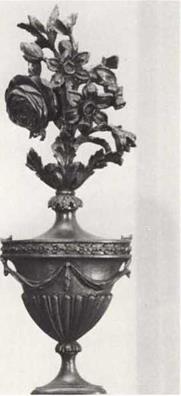
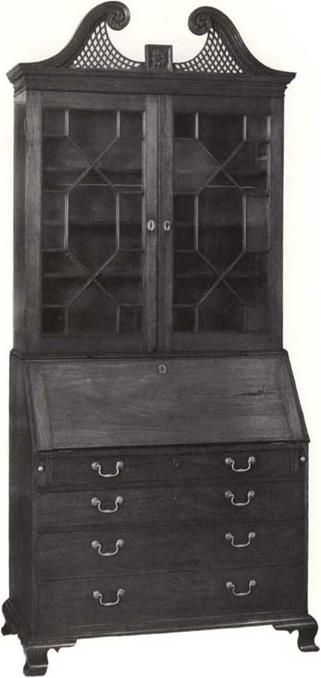
91. Desk-and-Bookcase, origin unknown, circa 1790. Mahogany and mahogany veneer primary; yellow pine and poplar secondaty.
Height 93 /:", width 44/:", depth 21 Vi".
Mr. and Mrs. James R. Melchor.
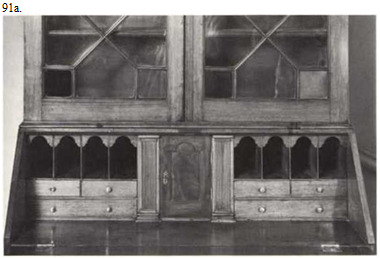
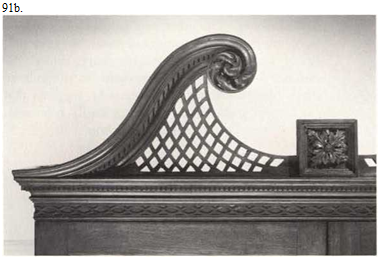 The provenances of these pieces are not helpful at this time in determining their origin. The first desk-and-bookcase (fig. 90) belonged to Dabney Minor of “Wood Lawn” in Orange County, Virginia, and the second (fig. 91) to Branch Tanner of Petersburg, Chesterfield County, and Amelia County.6 The clothespress (fig. 92) has a Matthews County background. Each desk-and-bookcase has an original inscription: on the first, “Dabney Minor Jan. 24th, 1789” is penciled on top of the desk section; on the second, “B. Tanner” is penciled on the bottom.
The provenances of these pieces are not helpful at this time in determining their origin. The first desk-and-bookcase (fig. 90) belonged to Dabney Minor of “Wood Lawn” in Orange County, Virginia, and the second (fig. 91) to Branch Tanner of Petersburg, Chesterfield County, and Amelia County.6 The clothespress (fig. 92) has a Matthews County background. Each desk-and-bookcase has an original inscription: on the first, “Dabney Minor Jan. 24th, 1789” is penciled on top of the desk section; on the second, “B. Tanner” is penciled on the bottom.
These appear to be the original owners’ names, which were probably inscribed in the cabinet shop to denote the customer. This may have been to prevent confusion w ith pieces being made there for other patrons, and it is also possible that these markings were used for shipping purposes.
These pieces are related to Williamsburg construction through the method by which the two sections were joined. Figures 90 and 91 show the waist molding attached to the sides of the bookcase but not to the top of the desk as usually seen in other areas. The evolution of this Williamsburg feature is discussed in the text accompanying figures 76, 77, 78, and 82. The Palace desk (fig. 78) shows the latest and simplest phase of this evolution, which is identical with one exception: wooden pegs are used for attachment instead of two screws. The clothes – press differs only in the placement of the molding, which has been applied to the lower section and does not form a lip. Like the desk-and-bookcases, the upper section rests directly on the bottom and is secured by two screws.
Both desk pediments had a central plinth, w hich was composed of a carved rosette w ith a molded frame. A complete plinth survives on the glazed example (fig. 91b) w hile the other (fig. 90a) retains only the bottom element of the molded frame. The design of these plinths is unusual. Philadelphia lattice-work pediments are probably the inspiration for these V irginia examples, and these normally have a half-cylindrical plinth with carving, although a few are rectangular w ith an applied fret. English examples studied by the author do not have the framed plinth w ith central rosette. In this respect, the Tanner and Minor desks appear to represent a single shop, although they may also reflect a larger regional style.
It is important to note that these desk-and – bookcases relate to another Virginia piece, a Williamsburg clothespress by Peter Scott (fig. 42), where surviving evidence suggests that a square or rectangular plinth was used in the center of the fretwork gallery. While it may not be valid to link these desks to Williamsburg on the basis of their
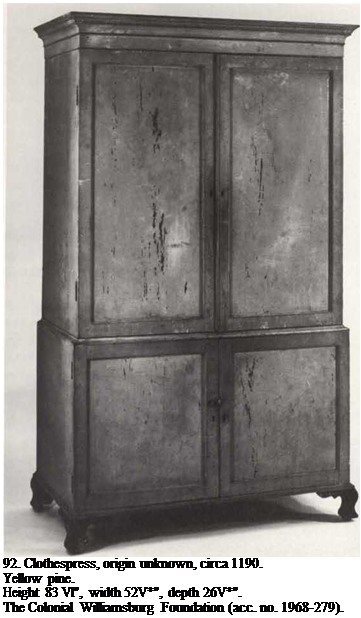 plinths, other associations give it more credence. In addition to their relationship to Williamsburg interlock joints, previously discussed, the carving of the acanthus scrolls is quite similar to some of Buck – trout’s carving, particularly its concentration on concave elements. The molding of the drawers of figure 90 are cut on the solid fronts and do not overlap the case—a feature seen on several Williamsburg examples (figs. 78, 79, 82). The drawer bottoms are set into grooves and have small glue – blocks w ith spaces betw een them. This construction method is seen on pieces attributed to Bucktrout, but during the post-Re volutionary period it was becoming quite universal. Thus its value as an archetype is somew hat diminished.
plinths, other associations give it more credence. In addition to their relationship to Williamsburg interlock joints, previously discussed, the carving of the acanthus scrolls is quite similar to some of Buck – trout’s carving, particularly its concentration on concave elements. The molding of the drawers of figure 90 are cut on the solid fronts and do not overlap the case—a feature seen on several Williamsburg examples (figs. 78, 79, 82). The drawer bottoms are set into grooves and have small glue – blocks w ith spaces betw een them. This construction method is seen on pieces attributed to Bucktrout, but during the post-Re volutionary period it was becoming quite universal. Thus its value as an archetype is somew hat diminished.
A related desk recorded in the research files of the Museum of Early Southern Decorative Arts (no. S-7652) has further tics to W illiamsburg and also shares features with the first five examples in this group. The interior document drawers have fluted pilasters with molded bases and capitals, and they flank an unusual prospect door backed by a mirror. The pilasters are quite similar to those on the Tanner and Minor desk-and-bookcases (figs. 90, 91), thus providing further links with W illiamsburg. Even though the desk appears to date circa 1770, it is inscribed “March 9, 1789 J. C.” on a document drawer. I’he inscription might represent the initials of a repairman or owner, but it could also be the mark of the maker and the date of production. The only documented W illiamsburg cabinetmaker who could be considered a candidate is John Crump, w ho is known to have been working between 1770 and 1777, but it is possible that he was practicing his craft over a longer period.
In summary, these three pieces (figs. 90, 91, 92) have a number of characteristics associated w ith Williamsburg. The exact location of their production is undetermined, and it will understandably remain s«) until more is known about the production of Norfolk, Petersburg, Richmond, and post-war W illiamsburg. The other case pieces in this section have interrelated features and local histories that firmly attribute them to Williamsburg, though the number of shops they represent is difficult to determine. Some evidence certainly suggests that the largest group (figs. 75-84) probably represents production of the Anthony Hay shop.
1. Wallace В. Guslcr. “Queen Anne Style Desks from the Virginia Piedmont,” The Magazine Antiques 104 (October 1973):665-673.
2. A receipt currently owned by Galt descendants records the sale of this chest: "Jan 14th 1888 Received from Mollic J. Galt $30.00 for the Dunmorc bureau. Julia E. Lindsay for Susan M. Christian." A copy of this receipt is on lile in the Department of Collections, Colonial Williamsburg Foundation, Williamsburg, Virginia.
3. Three examples from this group, or shop, are known. The best is owned by Mr. and Mrs. William Adams of Richmond, Virginia, and has a Gloucester County history. The two others descended in Williamsburg families: one is complete, and another survives only as a bookcase. The latter descended in the Galt family and has an early nineteenth-century stand similar to the one shown here dig. 85). Numerous features tic these together and distinguish them from other W illiamsburg groups. They have an abundance of oak secondary wood, cock (leading nailed onto the edges of the draw ers, a large double-bead molding on the front of the bookcase shelves, and a Battened astragal arch tin the raised panels of the doors.
4. Society of Upholsterers, Cabinet-Makers, Etc., The ltd Edition of Genteel HousHold Furniture in the Present Taste (London: Robert Sayer, Map and Printscllcr, ca. 1765), plate 55.
5. Colonial Williamsburg recently acquired a Pembroke table (accession no. 1978-83) that descended in the Prentis family of Williamsburg. Though damaged, it is a remarkable example, and can tic compared to tables illustrated in Chippendale’s Director, having shelves enclosed within fretwork beneath the skirts. The draw er of that table is identical in construction to those on this chest (fig. 86). Since Richard Booker, a Williamsburg cabinetmaker, made a Pembroke table for Colonel John Prentis sometime between 1770 and 1780, it is possible that these examples represent Booker’s work. While more documentation is needed to confirm such an attribution, the Scott details (font construction) of the chest lend some support, since Booker’s shop was very near, if not beside, Scott’s in the 1770s.
6. According to research conducted by the present owner, this desk apparently remained in Petersburg until Branch Tanner’s death in 1793 (Tanner’s will is on file in Amelia County). It was then passed (by purchase?) to Tanner’s neighbor. Col. Joseph Bragg, and descended in the Bragg family to William, ca. 1825; to his daughter Elizabeth Page Bragg Dunn. ea. 1855; to Lucy Frances Dunn Osborne, ca. 1880; to Mary M. Osborne Bryan, ca. 1921; and to Frances Osborne Bryan Humphreys, ca. 1971. It was then sold to Craig and Tarlton, Inc. and w as later purchased by Mr. and Mrs. James R. Melchor.
|
Figure 101 |

